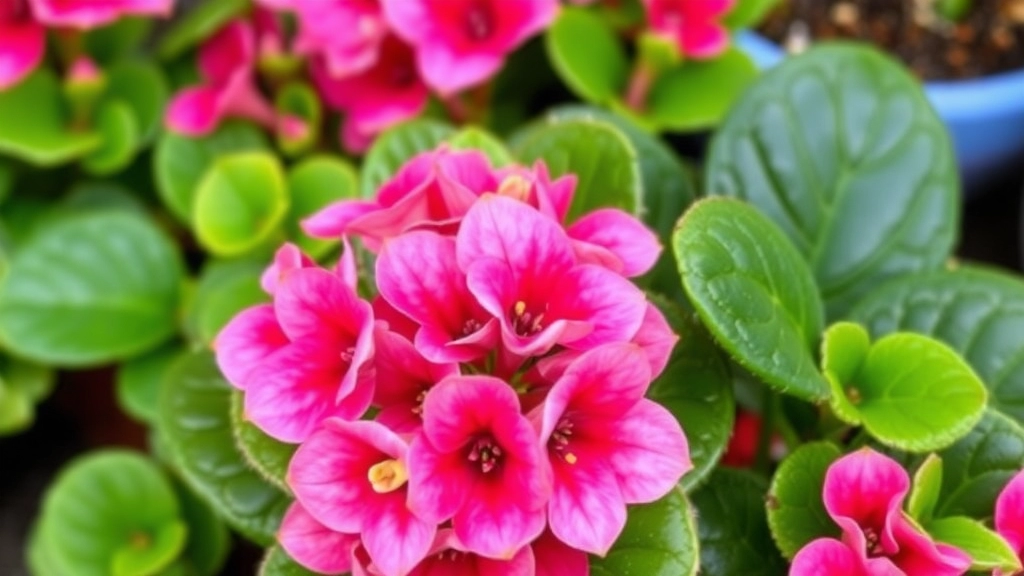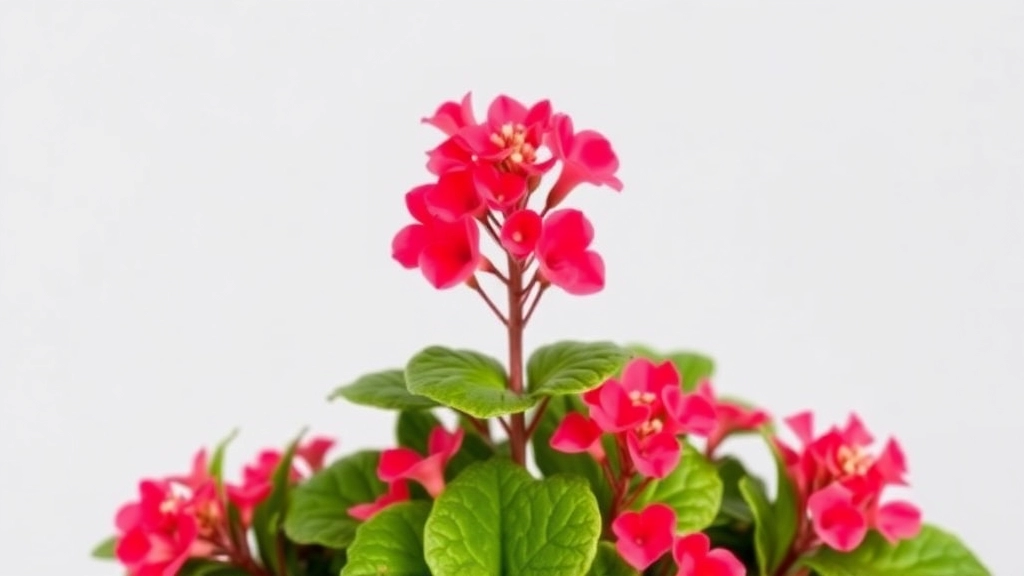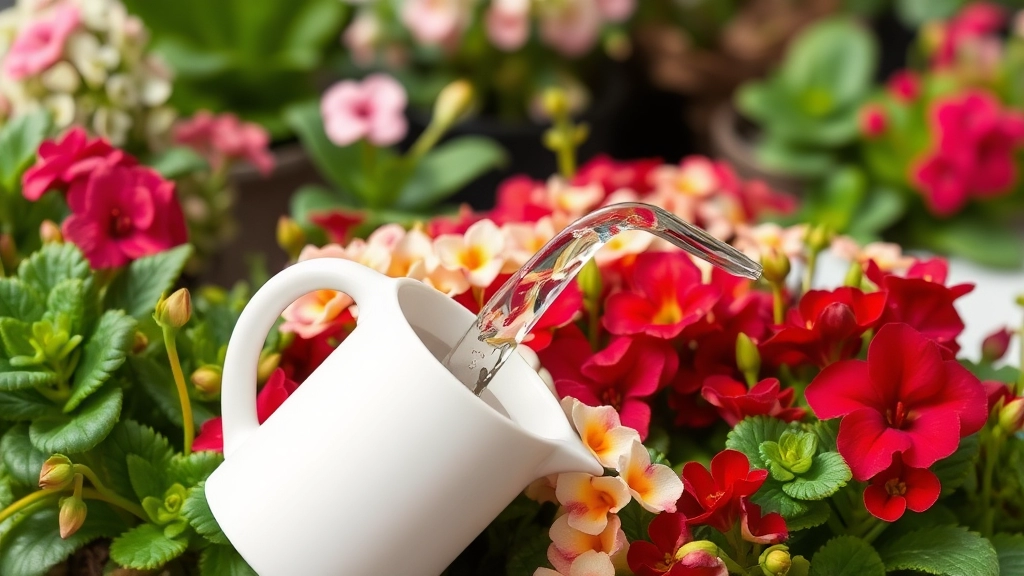Mastering the Art of Watering Kalanchoe
As a florist with years of experience nurturing various plants, I’ve come to appreciate the unique charm and resilience of Kalanchoe. In this article, I’ll share my insights on mastering the art of watering these beautiful succulents. We’ll explore the ideal watering schedule, common pitfalls to avoid, and how to adjust your care routine with the seasons. Whether you’re a novice plant parent or a seasoned gardener, these tips will help your Kalanchoe thrive.
Understanding Kalanchoe Care
From understanding the plant’s basic needs to recognizing signs of over and under-watering, we’ll cover all aspects of Kalanchoe care. I’ll also delve into the importance of proper soil and drainage, and share some pro tips on maintaining healthy Kalanchoe plants. By the end of this article, you’ll be equipped with the knowledge to keep your Kalanchoe flourishing year-round. Let’s dive in and unlock the secrets to becoming a true Kalanchoe whisperer!
Understanding Kalanchoe Plant Needs
Ever looked at your Kalanchoe and thought, “What the heck do you want from me?” I’ve been there, mate. These succulents might seem low-maintenance, but they’ve got their quirks.
Here’s the lowdown on what makes these plants tick:
- Light: These guys are sun-lovers. They’re basically the beach bums of the plant world.
- Soil: Well-draining soil is their jam. Think sandy, not swampy.
- Temperature: They’re not fans of the cold. Keep ’em cosy, around 15-25°C.
- Humidity: Unlike some drama queen plants, Kalanchoes aren’t fussed about humidity.
But here’s the kicker – water. It’s the make-or-break factor for Kalanchoes. Get it wrong, and you’re in for a world of plant drama.
So, what’s the secret sauce to watering Kalanchoes? It’s all about finding that sweet spot. Too much, and you’re drowning the poor thing. Too little, and it’s giving you the silent treatment.
Remember, Kalanchoes are succulents. They’re built to store water like a camel. Overwatering is a rookie mistake I’ve made more times than I’d like to admit.
The golden rule? Less is more. These plants would rather be a bit thirsty than swimming in excess water.
Bottom line: Understanding Kalanchoe plant needs is your ticket to keeping these beauties thriving. Get the basics right, and you’re halfway there. But nailing that watering schedule? That’s where the real magic happens.
Ideal Watering Schedule for Kalanchoe
Ever wondered how often you should water your Kalanchoe? Let’s break it down.
Kalanchoes are succulents, so they’re pretty chill about water.
Here’s the deal:
- Water every 2-3 weeks in spring and summer
- Cut back to once a month in autumn and winter
But here’s the thing – it’s not just about the calendar.
You’ve gotta feel the soil.
Stick your finger about an inch deep. If it’s dry, it’s watering time.
Overwatering is a bigger problem than underwatering for these guys.
So, when in doubt, wait it out.
Remember:
- Less is more with Kalanchoes
- They’d rather be thirsty than drowning
Got a Kalanchoe blossfeldiana in a small pot? It might need water more often.
Big pot? You can probably stretch out the watering schedule.
The key? Get to know your plant.
Watch how it responds to your watering routine.
Adjust as needed.
And don’t forget – drainage is crucial.
No one likes wet feet, especially not Kalanchoes.
So, there you have it. Water wisely, and your Kalanchoe tomentosa watering routine will help your plant thrive.
Signs of Overwatering and Underwatering
Let’s face it, watering Kalanchoe can be a bit tricky. I’ve been there, staring at my plant, wondering if I’m giving it too much love or not enough. So, let’s break this down and make it dead simple.
Overwatering: The Silent Killer
Ever seen your Kalanchoe looking a bit… soggy? That’s overwatering for you. Here’s what to watch out for:
- Yellowing leaves (and not in a cool, autumn way)
- Soft, mushy stems (nobody likes a mushy stem)
- Drooping leaves that feel wet and heavy
- Brown spots on leaves (like your plant’s got the flu)
- Mould on the soil surface (gross, right?)
Underwatering: The Thirst is Real
On the flip side, if your Kalanchoe’s looking more parched than you after a night out, you might be underwatering. Look for:
- Crispy, brown leaf edges (like overcooked bacon)
- Drooping leaves that feel dry and papery
- Slow growth (or no growth at all – yikes!)
- Leaves falling off easier than usual
The Goldilocks Zone
Finding that sweet spot is key. You want your Kalanchoe to be just right – not too wet, not too dry. It’s like making the perfect cup of tea, you know?
Quick Tip: Stick your finger about an inch into the soil. If it’s dry, give it a drink. If it’s still moist, hold off. Easy peasy!
Remember, it’s better to underwater than overwater. Kalanchoes are tough little suckers – they can bounce back from being a bit thirsty, but too much water can lead to root rot, and that’s a whole other kettle of fish.
So, keep an eye out for these signs, and you’ll be well on your way to Kalanchoe mastery. Trust me, once you get the hang of it, you’ll be the plant whisperer of your friend group. Now, who’s ready to tackle watering like a pro?
Best Practices for Watering Kalanchoe

Alright, let’s talk about watering your Kalanchoe like a pro.
First things first: these succulents are tough cookies.
They don’t need you hovering over them with a watering can 24/7.
Here’s the deal:
- Water deeply, but infrequently
- Let the soil dry out between waterings
- Aim for the base of the plant, not the leaves
- Use room temperature water (they’re not fans of cold showers)
Now, here’s a game-changer:
The finger test.
Stick your finger about an inch into the soil.
If it’s dry, it’s watering time.
If it’s still moist, hold off.
Simple, right?
But wait, there’s more:
- Water in the morning (gives the plant time to drink up before night)
- Use a pot with drainage holes (no one likes wet feet)
- Reduce watering in winter (Kalanchoe blossfeldiana likes to chill out)
Here’s a pro tip:
Bottom watering.
Place your pot in a tray of water for about 15 minutes.
The plant will suck up what it needs.
No guesswork, no overwatering.
Remember:
It’s easier to save an underwatered Kalanchoe than an overwatered one.
When in doubt, wait it out.
Your Kalanchoe tomentosa will thank you for mastering these watering best practices.
Seasonal Watering Adjustments
Alright, let’s chat about how to keep your Kalanchoe happy all year round. Trust me, these little succulents can be drama queens when it comes to water!
Summer Sipping
When the mercury rises, your Kalanchoe’s gonna be thirstier than usual. Here’s the deal:
- Water more frequently, but don’t go overboard
- Check the soil every 3-4 days
- If the top inch feels dry, it’s time for a drink
Winter Watering Wisdom
Cold months? Time to ease up on the H2O. Your plant’s basically hitting the snooze button:
- Cut back watering to once every 2-3 weeks
- Always check the soil first – bone dry? Give it a sip
- Remember: overwatering in winter is a fast track to root rot
Spring and Autumn Adjustments
These in-between seasons can be tricky. Keep an eye out:
- Gradually increase (spring) or decrease (autumn) watering
- Let the plant’s behaviour guide you – droopy leaves? Might need more water
- Stick to the “check before you water” rule
Pro Tip: I always keep a calendar reminder for seasonal changes. It’s a lifesaver when you’re juggling multiple plants!
Remember, Kalanchoes are succulents at heart. They’d rather be a bit thirsty than swimming in excess water. By tweaking your watering routine with the seasons, you’ll keep your Kalanchoe thriving all year long. It’s all about finding that sweet spot between desert dry and tropical rainforest!
When it comes to watering your Kalanchoe, picking the right tools can make all the difference. Let’s chat about what works best.
First up, forget the big watering can. It’s overkill for these little succulents. Instead, go for a small, precise watering can with a narrow spout. Why? It gives you more control, helping you avoid overwatering.
Here’s what I use and recommend:
– A mini watering can (about 1-2 litres)
– A spray bottle for misting (great for humidity)
– A moisture meter (takes the guesswork out of watering)
Pro tip: If you’re feeling fancy, try a self-watering globe. They’re pretty cool.
But here’s the thing – your finger can be just as good as any tool. Stick it in the soil. If it’s dry up to your first knuckle, it’s watering time.
Remember, Kalanchoes are succulents. They’re tough cookies that don’t need much water. In fact, the Kalanchoe Blossfeldiana temperature tolerance makes them quite resilient to various conditions.
So, whatever tool you choose, less is more. Keep it simple, keep it precise, and your Kalanchoe will thank you. If you’re looking to expand your collection, you might want to consider the Kalanchoe Beharensis Snowflake, which has unique watering needs.
Soil and Drainage Considerations
Let’s chat about soil and drainage for your Kalanchoe – it’s not just about throwing some dirt in a pot and calling it a day. Trust me, I’ve learned this the hard way!
Soil Matters, Big Time
First things first, Kalanchoe plants are succulents. They’re not fans of sitting in soggy soil. So, what’s the secret sauce? Well, it’s all about that well-draining mix. Here’s what I use:
- 2 parts regular potting soil
- 1 part perlite or coarse sand
- 1 part pumice or small gravel
This combo gives your Kalanchoe the perfect balance of moisture retention and drainage. It’s like giving your plant a cozy home with just the right amount of breathing room.
Drainage: The Unsung Hero
Now, let’s talk drainage. It’s not sexy, but it’s crucial. Without good drainage, your Kalanchoe’s roots will be swimming, and trust me, they’re not Olympic athletes.
Here’s what you need to know:
- Always use pots with drainage holes. No exceptions!
- Add a layer of small rocks or pebbles at the bottom of the pot.
- Don’t forget to empty that saucer after watering. Stagnant water is a no-go.
Pro Tip: If you’re repotting, gently loosen the roots and remove any old, compacted soil. Your Kalanchoe will thank you for the fresh start.
The pH Factor
Kalanchoes aren’t too picky about pH, but they do have a sweet spot. Aim for slightly acidic to neutral soil, around 5.8 to 6.5 pH. If you’re feeling fancy, grab a soil pH tester from your local garden center.
Remember, good soil and drainage are the foundation for a happy, healthy Kalanchoe. Get this right, and you’re already halfway to becoming a Kalanchoe whisperer. Trust me, your plants will be the envy of the neighborhood!
Common Mistakes to Avoid When Watering Kalanchoe

Let’s chat about the blunders folks often make when watering their Kalanchoe.
Trust me, I’ve been there, done that, and learned the hard way.
Here’s the lowdown on what not to do:
1. Overwatering: The #1 Kalanchoe killer
It’s tempting to shower your plant with love (and water), but easy does it.
These succulents are drought-tolerant, not aquatic plants.
2. Using a fixed schedule
Calendars are great, but your Kalanchoe doesn’t care what day it is.
Water when the soil’s dry, not because it’s Tuesday.
3. Ignoring the seasons
Your plant’s thirst changes with the weather.
Summer? More water. Winter? Less. Simple as that.
4. Watering the leaves
Aim for the soil, not the foliage.
Wet leaves can lead to fungal issues. Nobody wants that.
5. Using the wrong water
Tap water can be harsh on Kalanchoes.
Try rainwater or filtered water if you’re feeling fancy.
6. Forgetting about drainage
No drainage holes? That’s a recipe for root rot.
Make sure excess water has an escape route.
7. Watering at night
Early bird gets the worm, and morning watering gets the healthy plant.
Night watering can lead to fungal growth.
Avoiding these common mistakes will keep your Kalanchoe blossfeldiana flowering for longer periods. Remember, when it comes to watering Kalanchoe, less is often more. If you’re interested in unique varieties, check out the Kalanchoe tomentosa ‘Teddy Bear’ for a fuzzy twist on traditional Kalanchoe care.
Tips for Maintaining Healthy Kalanchoe Plants
Alright, let’s chat about keeping your Kalanchoe thriving.
It’s not rocket science, but there are some key things to remember.
First up, light is crucial. These guys love bright, indirect sunlight.
Too much direct sun? You’ll see scorched leaves. Not enough? Say goodbye to those vibrant blooms.
Now, about watering – it’s a balancing act.
- Water when the top inch of soil feels dry
- Avoid getting water on the leaves
- Don’t let them sit in water – drainage is key
Temperature matters too.
Kalanchoes are pretty chill, but they hate the cold. Keep them above 10°C (50°F).
Feeding time! Use a balanced, water-soluble fertiliser every month during growing season.
Pruning isn’t just for looks. It helps your plant stay bushy and encourages more flowers.
Pest patrol: Keep an eye out for mealybugs and spider mites. Catch ’em early, sort ’em out quick.
Repotting? Do it every couple of years. Your Kalanchoe will thank you with more growth.
Remember, these plants are tough cookies. Don’t baby them too much.
A little neglect can actually be good sometimes. They’re survivors.
The secret sauce? Observation. Get to know your plant’s quirks.
Every Kalanchoe is unique, just like us. Learn its language, and you’ll have a happy, healthy plant in no time.
Frequently Asked Questions about Kalanchoe Watering
How often should I water my Kalanchoe?
Generally, water your Kalanchoe every 2-3 weeks during spring and summer, and once a month in autumn and winter. However, always check the soil moisture before watering. If the top inch of soil is dry, it’s time to water.
Can I use tap water for my Kalanchoe?
While tap water is usually fine, some Kalanchoes can be sensitive to chemicals in tap water. If possible, use rainwater or filtered water. If using tap water, let it sit out overnight to allow chlorine to evaporate.
How do I know if I’m overwatering my Kalanchoe?
Signs of overwatering include yellowing leaves, soft mushy stems, and mold on the soil surface. If you notice these symptoms, reduce watering frequency and ensure proper drainage.
What’s the best way to water a Kalanchoe?
Water at the base of the plant, avoiding the leaves. Use a small watering can with a narrow spout for precision. Alternatively, try bottom watering by placing the pot in a tray of water for about 15 minutes.
Should I mist my Kalanchoe?
Kalanchoes don’t require high humidity, so misting isn’t necessary. In fact, excess moisture on the leaves can lead to fungal problems. Focus on proper soil watering instead.
Do Kalanchoes need special soil?
Yes, Kalanchoes thrive in well-draining soil. A mix of regular potting soil, perlite, and pumice or small gravel works well. This ensures good drainage while retaining some moisture.
How do seasonal changes affect Kalanchoe watering?
Kalanchoes need more water in spring and summer when they’re actively growing. In autumn and winter, reduce watering as the plant enters a semi-dormant state. Always adjust based on your plant’s specific needs and environment.
Can I use self-watering pots for Kalanchoes?
While self-watering pots can work, they’re not ideal for Kalanchoes. These plants prefer to dry out between waterings, which can be difficult to achieve with self-watering systems. If you use one, monitor closely to prevent overwatering.
What should I do if I’ve overwatered my Kalanchoe?
If you’ve overwatered, stop watering immediately and move the plant to a brighter, warmer spot to help excess water evaporate. If the soil is very wet, you might need to repot with fresh, dry soil. In severe cases, check for root rot and trim affected roots.
How does pot size affect watering frequency?
Larger pots retain moisture longer, so you’ll need to water less frequently. Smaller pots dry out faster and may require more frequent watering. Always check the soil moisture regardless of pot size before watering.

